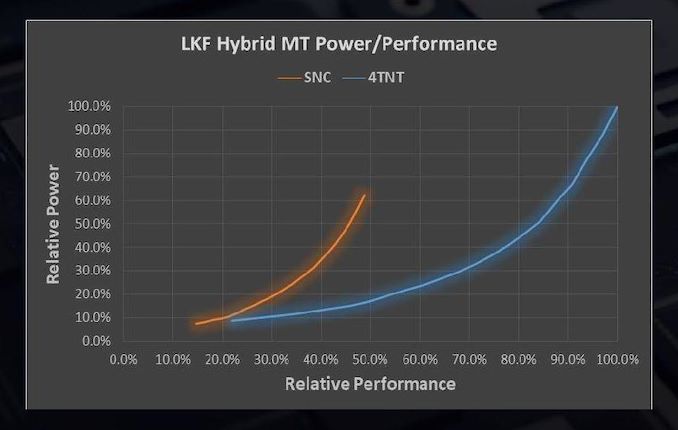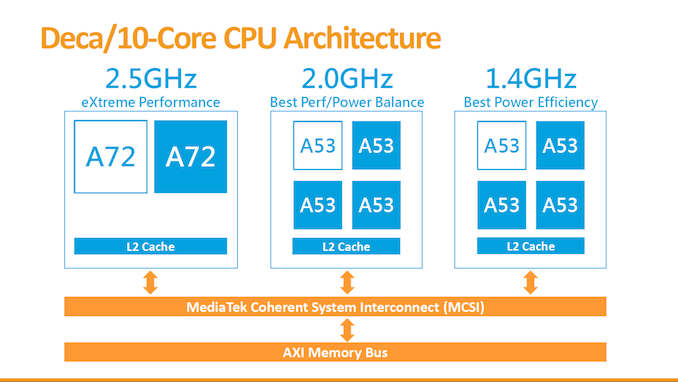The Intel Lakefield Deep Dive: Everything To Know About the First x86 Hybrid CPU
by Dr. Ian Cutress on July 2, 2020 9:00 AM ESTHow To Treat a 1+4 Hybrid CPU
At the top of the article, I explained that the reason for using two different types of processor core, one big on performance and the other big on efficiency, was that users could get the best of both worlds depending on if a workload could be run efficiently in the background, or needed the high performance for a user experience interaction. You may have caught onto the fact that I also stated that because Intel is using a 1+4 design, it actually makes more sense for multi-threaded workloads to run on the four Atom cores.
Using a similar power/performance graphs, the effect of having a 1+4 design is quite substantial. On the left is the single core power/performance graphs, but on the right is when we compare 1 Sunny Cove to all 4 Tremont cores working together.
Where the previous graph considered a 1+1 design, which is more relevant in those user experience scenarios listed above, on the right is the 1+4 design for when the user demands a heavier workload that might not be latency critical. Because there are four Atom cores, the blue line multiplies by four in both directions.
Now obviously the real world scenario is somewhere between the two, as it is possible to use only one, two, or three of the smaller cores at any given time. The CPU and the OS is expected to know this, so it can govern when workloads that can be split across multiple cores end up on either the big core or the small core.
In this graph from Intel, we have three distinct modes on which threads can operate.
- ‘Sunny Cove/SNC’ is for responsiveness and user experience threads,
- ‘Tremont/TNT Foreground’, for user related tasks that require multiple threads that the user is waiting on.
- ‘Tremont/TNT Background’, for non-user related tasks run in efficiency mode
Even though the example here is web browsing, it might be best to consider something a bit beefier, like video encoding.
If we run video encoding, because it is a user related task that requires multiple threads, it will run on the four Tremont cores (TNT FG). Anything that Windows wants to do alongside that gets scheduled as TNT BG. If we then open up the start menu, because that is a responsiveness task, that gets scheduled on the SNC core.
Is 1+4 the Correct Configuration?
Intel here has implemented a 1+4 core design, however in the smartphone space, things are seen a little differently. The most popular configuration, by far, is a 4+4 design, simply because a lot of smartphone code is written to take advantage of multiple foreground or multiple background threads. There are a number of cost-down designs that reduce die area and power by going for a 2+4 implementation. Everyone seems adamant that 4 is a good number for the smaller cores, partly because they are small and cheap to add, but because Arm’s quad-core implementation is a base unit for its IP.
The smartphone space in recent quarters has also evolved from a two tier system of cores. In some of the more leading edge designs, we now have three types of core: a big, a middle, and a small. Because of the tendency to stay with eight core designs, we now get 1+3+4 or 2+2+4 designs, powered by complex schedulers that manage where to put the threads for the best user experience, the best battery life, or somewhere in the middle. Mediatek has been famously dabbling in 10 core designs, going for a 2+4+4 approach.
One thing missing from all of these implementations is an SoC with one big core and four small cores. Smartphone vendors don’t seem to be interested in 1+4 silicon, and yet Intel has decided on it for Lakefield. This is borne out of decisions made on both sides.
From the smartphone perspective, when hybrid designs came about, the big cores just weren’t powerful enough on their own. In order to offer something more than simply basic, at least two cores were needed, but because of how Arm architected the big and little designs, it almost became standard to look into 4+4 implementations of big and small cores. It was only until this configuration was popularized over a couple of years, and Arm big cores got more powerful, that chip designs started looking at 2+4, or 1+3+4 designs.
On Intel’s side of the fence, the biggest problem it has is the size of the Sunny Cove core. By comparison, it’s really, really big. Because the graphics core is the same as Ice Lake and reuses its design, there simply isn’t enough room within the 82 mm2 compute die to add another core. Not only that, but there is a question of power. Sunny Cove wasn’t built for sub-1W operation, even in the Tremont design. We see big smartphone silicon pulling 4-5W when all eight cores are active – there is no way, based on our understanding of Intel’s designs, that we could see four (or even two) Sunny Cove cores being in the optimal performance per watt range while being that low. Intel’s Lakefield graphics, with 64 EUs, is running at only 500 MHz – a lot lower than the Ice Lake designs. Even if Intel moved that down to a 32 EU design to make space for another Sunny Cove core, I reckon that it would eat the power budget for breakfast and then some.
Intel has made the 1+4 design to act as a 0+4 design that sometimes has access to a higher performance mode. Whereas smartphone chips are designed for all eight cores to power on for sustained periods, Lakefield is built only for 0+4 sustained workloads. And that might ultimately be its downfall. This leads onto a deep discussion about Lakefield’s performance, and what we should expect from it.














221 Comments
View All Comments
Spunjji - Monday, July 6, 2020 - link
Given the cost of producing multiple dies, stacking them, and packaging the whole lot with RAM on top - I doubt even that's going to be particularly compelling. It probably would have been better if they'd transitioned fully to 10nm and had idle 14nm capacity, but as it stands this will be competing for manufacturing space with their own premium products on both lines. D:lmcd - Friday, July 3, 2020 - link
This isn't designed for Windows. This is designed for Windows 10X. Windows 10X got delayed so partners are shipping it with Windows.serendip - Friday, July 3, 2020 - link
Will Win10X bring a magical doubling in performance?Spunjji - Monday, July 6, 2020 - link
My thoughts exactly. I feel like they've tried to do too many things at the same time with this product.They obviously wanted to demonstrate Foveros with a relatively low-complexity, relatively low-power chip - but the cost of the first-gen Foveros tech conflicts with one of the big primary selling points of small chips in the first place, i.e. lower cost. So they've gone for a "premium" product, but the first-gen Foveros tech puts a fairly low ceiling on its performance - meaning it's not actually very premium in practice.
It's a quagmire of mutually contradictory requirements, and tbh that's pretty on-par with Intel's previous efforts in the low-power CPU arena.
lmcd - Thursday, July 2, 2020 - link
Honestly confused why everyone is up in arms about the lack of AVX. This is a tablet SoC for Windows 10X and any other usage of it is outside of its intended scope. Future SoCs might add more of this functionality but it doesn't really seem like a priority. A low-power SoC that also won't wilt to the render thread and "just works" with legacy x86-only apps when necessary sounds good to me.Spunjji - Monday, July 6, 2020 - link
I think it's mainly that Intel have spent so much time selling that feature so hard, then dropped it - albeit without actually physically removing it. So, once again, Intel are charging their customers money to manufacture something in silicon that they can't actually use.xdrol - Thursday, July 2, 2020 - link
The Snapdragon 7c is more like a 2+6 than a 0+8 chip: It has 2x Kryo Gold (Cortex A76) and 6x Kryo Silver (A55) cores.Sychonut - Friday, July 3, 2020 - link
I am not sure I understand whether the added design complexity is justified by the very minor power savings as depicted by the power / performance graph on page 1, or am I reading it wrong? The difference between the two curves seems marginal at best below 58%.ichaya - Friday, July 3, 2020 - link
That seems like the most meaningful part of the chart. You can still deliver 60%+ performance with only 30-50% of the power.This is a 1st gen attempt and a 2+4 design with AVX and ARM's System-level cache would definitely be interesting to see in ultra portables.
unclevagz - Friday, July 3, 2020 - link
Which itself is not a good showing for the 'efficiency' core, the small thunder cores in the Apple A13 are at ~20-30% of the Lightning core's performance while consuming 5-15% of the power (2-3x perf/watt) . And the A13 Lightning in all likelihood already runs rings around the lakefield cores in this department.